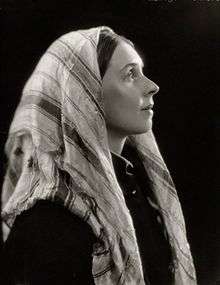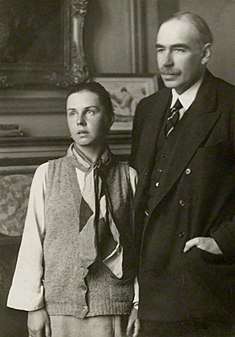Lydia Lopokova
Lydia Lopokova, Baroness Keynes (born Lidia Vasilyevna Lopukhova, Russian: Ли́дия Васи́льевна Лопухо́ва; 21 October 1892 – 8 June 1981) was a Russian ballerina famous during the early 20th century.
Lydia Lopokova | |
|---|---|
 Lydia Lopokova in 1922 | |
| Born | Lidia Vasilyevna Lopukhova 21 October 1892 |
| Died | 8 June 1981 (aged 88) Seaford, East Sussex, England |
| Nationality | Russian |
| Occupation | Ballerina |
| Title | Lady Keynes |
| Spouse(s) | John Maynard Keynes |
| Relatives | See Keynes family |
Lopokova was born into a family of ballet dancers, and trained at the Imperial Ballet School. She toured with the Ballets Russes in 1910, and moved to the United States soon after.
Lopokova married the renowned English economist John Maynard Keynes in 1925, and was also known as the Lady Keynes. She largely disappeared from public view after Keynes's death in 1946, and spent her remaining years in Sussex.
Early life
Lopokova was born into a Russian family in St. Petersburg.[1] Her father worked as the chief usher at the Alexandrinsky Theatre; her mother was descended from a Scottish engineer.[2] All the Lopukhov children became ballet dancers; one of them, Fyodor Lopukhov, was a chief choreographer for the Mariinsky Theatre from 1922 to 1935 and again from 1951 to 1956.
Lydia trained at the Imperial Ballet School, where she almost immediately became a star pupil.[1] "She responded instinctively to the expressive choreography of Mikhail Fokine, his rebellion against the stiff academicism of the classical style, and her chance came when she was chosen to join the Ballets russes... on their European tour in 1910.... Diaghilev knocked a year off her age and promoted her as a child star."[3] She stayed with the ballet only briefly, knowing that she had little future in Russia ("she was the wrong size and shape for the grand roles and there were already plenty of prima ballerinas in St. Petersburg").[3]
America
.jpg)
She accepted an American offer of £16,000 per month and after the summer tour left for the United States, where she remained for six years, enjoying tremendous success and legally changing her name to Lopokova in April 1914.[4]
In 1915, while in New York, she had become engaged to the New York Morning Telegraph sportswriter Heywood Broun, later a member of the celebrated Algonquin Round Table coterie. In 1916 she broke off their engagement, or perhaps Broun did: according to Fred Lieb, another sportswriter and a friend of Broun's at the time, Broun "caught the enchanting Lydia Lapopka in the lap, so to speak, of her Russian director.... [Broun] walked east on one street, knocking over every garbage and trash can he passed. Then he walked west on the street giving it the same treatment. Just as he was getting really warmed up to the sport he ran into the hands of the law. Heywood spent the night in the hoosegow before friends bailed him out the next morning."[5]
Actually, if Broun indeed caught her in flagrante, it was not in the lap of "her Russian director," Diaghilev, but the company's Italian business manager, Randolfo Barrocchi, whom she soon married. From her perspective, the union was ill-advised: "A 'glossy man of the world', he stole her earnings and — luckily — turned out to be a bigamist; meanwhile, in the midst of a wartime European tour, she had an on-off affair with Igor Stravinsky, who was married."[3]
In America she was basically a novelty act, and she rejoined Diaghilev in 1916, dancing with the Ballets Russes, and her former partner Vaslav Nijinsky, in New York and later in London. She first came to the attention of Londoners in The Good-humoured Ladies in 1918, and followed this with a raucous performance with Léonide Massine in the Can-Can of La Boutique fantasque. When her marriage to Barrocchi broke down in 1919, the dancer abruptly disappeared for a time, as she had done before in America.
Relationship with Keynes

In 1921, Diaghilev staged a lavish production of The Sleeping Beauty in which Lopokova danced the Lilac Fairy and Princess Aurora. The production was a flop, but it brought her to the attention of John Maynard Keynes.[2] He "sat every night in the stalls, enchanted by Lydia as the Lilac Fairy casting spells over the cradle."[3] The two soon became lovers, and they were married in 1925, once her divorce from Barrocchi had been obtained. Until now, Keynes's closest relationships had been with the members of the Bloomsbury group, especially Vanessa Bell and Duncan Grant, who had been the great love of his life. They and other members of the group, such as Virginia Woolf and Lytton Strachey, found Lydia difficult to accept and were resistant to her partnership with Keynes for many years even after their marriage took place.[6] (Some of them later regretted their snobbery; E.M. Forster, for example, wrote: "How we all used to underestimate her.") However, she maintained friendships with many other members of London's cultural elite of the time, including T. S. Eliot[7] and H.G. Wells.[6] During these years she became a friend of Picasso, who drew her many times. Lopokova is represented as Terpsichore, the muse of dancing, in The Awakening of the Muses, a mosaic at the National Gallery, London, laid by Boris Anrep in 1933. Also in 1933 she danced her last ballet role, as Swanilda in Coppélia, for the new Vic-Wells Ballet.
The couple spent their honeymoon in Sussex, England in 1925. A fortnight into the honeymoon they were briefly visited by the philosopher Ludwig Wittgenstein. Lydia remarked to Wittgenstein "What a beautiful tree", Wittgeinstein responded glaringly asking "what do you mean?" which caused Lydia to burst into tears.[8]
Later life
Besides being involved in the early days of English ballet, Lopokova appeared on the stage in London and Cambridge from 1928, and was broadcast on the BBC as a presenter and in a number of acting roles; she read "The Red Shoes" over the BBC in 1935 (and a few years later reprised it for BBC television). She lived with Keynes in London, Cambridge and Sussex. "Lopokova was [Keynes's] partner in founding the Cambridge Arts Theatre, and in advising him on the constitution for the Arts Council; with his financial input she became a moving spirit in the Camargo Society, which led to the creation of a national ballet company."[9] After her husband's collapse from an attack of angina in 1937, Lopokova devoted herself increasingly to taking care of his health.[2] She supervised his diet and made sure he had enough rest; "without her constant attention and her joie de vivre, Keynes might not have made it to Bretton Woods."[3]
Death
After Keynes's death in 1946, she largely disappeared from public view and lived in Tilton House, Sussex for her remaining years. Lopokova died in the Three Ways Nursing Home in Seaford in 1981, at 88.[1]
Biographies
Her husband's nephew Milo Keynes wrote a biography, Lydia Lopokova (St. Martin's Press, 1983, ISBN 0312500394); more recently Judith Mackrell has published Bloomsbury Ballerina: Lydia Lopokova, Imperial Dancer and Mrs John Maynard Keynes (Weidenfeld, 2008, ISBN 0297849085).
References
- Dunning, Jennifer (30 June 1981). "Lydia Lopokova, 88, Ballerina, is Dead". New York Times. Retrieved 10 February 2010.
Lydia Lopokova, a leading ballerina of Serge Diaghilev's Ballets Russes and a popular figure on the English social and ballet scenes, died June 8 in England. She was 88 years old. Miss Lopokova trained at the Imperial Ballet School in St. Petersburg, where she was born, and joined the Diaghilev company in 1910...
- "The unlikely Lydia Lopokova". The Telegraph. London. 25 April 2008. Retrieved 10 February 2010.
- Alison Light, "Lady Talky," London Review of Books, 18 December 2008.
- Lydia and Maynard: Letters between Lydia Lopokova and John Maynard Keynes (André Deutsch, 1989), p. 20.
- Lieb, Fred (1977). Baseball As I Have Known It. New York: Coward, McCann & Geoghegan. p. 214.
- Judith Mackrell, "Carrying on with L", The Guardian, 22 March 2008.
- Oxford Dictionary of National Biography, Oxford University Press, 2004
- Wittgenstein's Poker, page 194
- Times Literary Supplement, 20 June 2008, p. 12.
External links

- Chapter 7 Interactive E-Book John Maynard Keynes: The Lives of a Mind (2016). The Keynes Centre University College Cork
- Lydia Lopokova at Find a Grave